Family name: Cyperaceae Jussieu
Synonym(s): Kobresiaceae Gilly
Common name(s): sedge family
*Number of genera/species: 90/5,500
List of genera records in GRIN-Global
fruit
Fruit usually an acheneachene:
a dry, indehiscent, one-seeded fruit, with seed attached to pericarp at a single point, derived from a single, superior, simple or compound, one-loculed ovary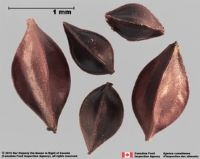 , rarely a berry, utricleutricle:
, rarely a berry, utricleutricle:
a small, indehiscent, dry fruit with a thin wall (bladderlike) that is loose and free from the seed, derived from a single, superior, simple ovary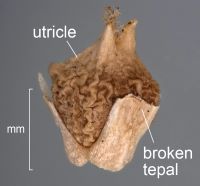 , or one-stoned drupedrupe:
, or one-stoned drupedrupe:
(indehiscent drupe) a fleshy, indehiscent fruit with one more hard pits enclosing seeds, derived from single, superior, simple or compound ovary; (dehiscent drupe) a fruit with a dry or fibrous to fleshy or leathery outer husk that early to tardily breaks apart (or opens), exposing one or more nutlike pits enclosing the seeds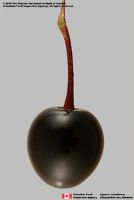 , 0.3–6 mm long, globoseglobose:
, 0.3–6 mm long, globoseglobose:
3D shape—more or less spherical to trigonoustrigonous:
to trigonoustrigonous:
3D shape—having three faces that meet at distinct angles; triangular in outline
, tereteterete:
approximately circular in cross section; width and thickness approximately equal
 , angledangular:
, angledangular:
2D shape—having sides that meet at acute or obtuse angles
, or compressedcompressed:
flattened; in grasses, used to denote compression (not necessarily flattened) either laterally or dorsiventrally
in transection, stylar remnants persistent, often beakedbeak:
a usually firm, terminal appendage, sometimes tapered , with one seed, usually enclosed in persistent perianthperianth:
, with one seed, usually enclosed in persistent perianthperianth:
collective term for calyx and corolla of a flower
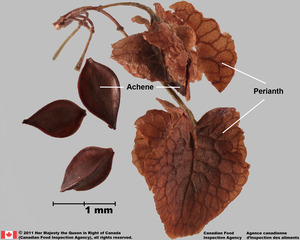 or membranousmembranous:
or membranousmembranous:
texture—extremely thin, pliable, and fairly tough
sac (perigyniumperigynium:
a sac-like structure surrounding the ovary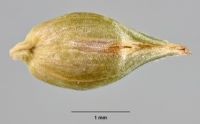 ). Fruits may be winged. Pericarppericarp:
). Fruits may be winged. Pericarppericarp:
fruit wall or fruit coat
is black, brown, gray, green, white, yellow, or orange, shinyshiny:
uniformly reflecting a high proportion of incident light at all angles or dulldull:
or dulldull:
reflecting only a low proportion of incident light, with no apparent sheen , crustaceouscrustaceous:
, crustaceouscrustaceous:
texture—thin, dry, indurate, and brittle
, indurateindurate:
texture—hardened or stony; yielding under strong pressure; not deformable without internal structural disruption
, or membranousmembranous:
texture—extremely thin, pliable, and fairly tough
, glabrousglabrous:
without hairs
or pubescentpubescent:
surface relief—bearing hairs
, smooth or variously ornamented.
Seeds ovoidovoid:
3D shape—ovate , fusiformfusiform:
, fusiformfusiform:
spindle-shaped; broadest at the middle and tapering at both ends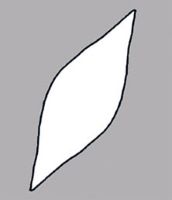 , or ellipsoidellipsoid:
, or ellipsoidellipsoid:
3D shape—elliptic
, tereteterete:
approximately circular in cross section; width and thickness approximately equal
 or compressedcompressed:
or compressedcompressed:
flattened; in grasses, used to denote compression (not necessarily flattened) either laterally or dorsiventrally
in transection, 0.3–6 mm long, rapheraphe:
a ridge or seam on the seed coat, formed by the portion of the funiculus united to the ovule wall in longitudinally curved ovules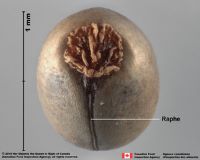 and chalazachalaza:
and chalazachalaza:
the region at the base of the ovule where the integuments are inserted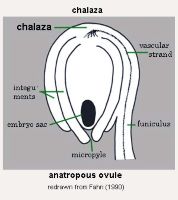 usually conspicuous, punctatepunctate:
usually conspicuous, punctatepunctate:
surface relief—dotted with pits or with translucent, sunken glands or with colored dots, similar to pitted hilumhilum:
hilumhilum:
on seeds, the scar indicating where the funiculus was attached; on grass caryopses, the scar visible on the outer fruit surface revealing where the seed is attached on the inner fruit wall surface; or in Asteraceae cypselae, the scar visible on the outer fruit wall revealing where the fruit was attached to the receptacle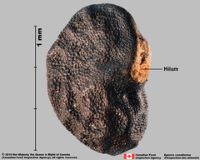 . Seed coat brown, thin, smooth. Seeds free of fruit wall.
. Seed coat brown, thin, smooth. Seeds free of fruit wall.
Embryo small but well developed, capitatecapitate:
head-shaped; abruptly enlarged on one end to a relatively short, terminal portion
or broad, curvedcurved:
(of embryo) linear embryo is curved into an arch or horseshoe with the ends far apart , transversetransverse:
, transversetransverse:
lying, situated, or placed across
to seed length and basalbasal:
at or pertaining to the point of attachment; (of embryo) embryo occupies one end of the seed
, partially filling seed coat.
Endosperm copious, smooth, fleshy, and opaqueopaque:
not transmitting light
.
Common weed in wetlands, swamps, paddy fields, and along riverbanks and lake margins that often forms dense clumps and can reduce crop yields. Spreads by seed reproduction, tuber, rhizome, or stolon clonal propagation.
Aquarium & Pond Plants of the World tool includes descriptions and images of genera, which may be encountered.
| Fruit | |
| Type | usually acheneachene: a dry, indehiscent, one-seeded fruit, with seed attached to pericarp at a single point, derived from a single, superior, simple or compound, one-loculed ovary  , rarely a berryberry: , rarely a berryberry:an indehiscent, fleshy fruit with one or a few to many seeds. The flesh may be homogenous throughout. Or, if the outer part is hard, firm, or leathery, referred to as an hesperidium. Septa are present in some, and the seeds may be arillate or with a fleshy testa. 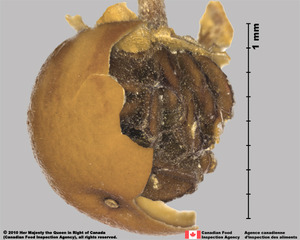 , utricleutricle: , utricleutricle:a small, indehiscent, dry fruit with a thin wall (bladderlike) that is loose and free from the seed, derived from a single, superior, simple ovary  , or one-stoned drupedrupe: , or one-stoned drupedrupe:(indehiscent drupe) a fleshy, indehiscent fruit with one more hard pits enclosing seeds, derived from single, superior, simple or compound ovary; (dehiscent drupe) a fruit with a dry or fibrous to fleshy or leathery outer husk that early to tardily breaks apart (or opens), exposing one or more nutlike pits enclosing the seeds  |
| Size range | 0.3–6 mm long |
| Shape(s) | ovoidovoid: 3D shape—ovate  , ellipsoidellipsoid: , ellipsoidellipsoid:3D shape—elliptic , oblongoblong: 2D shape—much longer than broad with nearly parallel sides, corners are rounded  , teardrop-shapedteardrop-shaped: , teardrop-shapedteardrop-shaped:2D shape—widest point is toward one end of the fruit, the other end tapers sharply to a pointed end 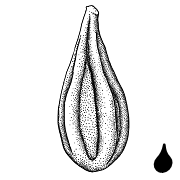 , heart-shapedheart-shaped: , heart-shapedheart-shaped:2D or 3D shape—one end has prominent double curved into two lobes, the other end angular or pointed 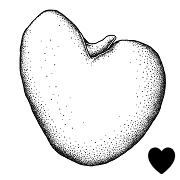 , globoseglobose: , globoseglobose:3D shape—more or less spherical  , lanceolatelanceolate: , lanceolatelanceolate:2D shape—lance-shaped; much longer than wide, with widest point below the middle, tapering to the apex (compare oblanceolate) 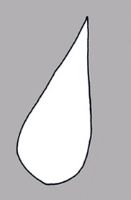 , trigonoustrigonous: , trigonoustrigonous:3D shape—having three faces that meet at distinct angles; triangular in outline |
| Texture | crustaceouscrustaceous: texture—thin, dry, indurate, and brittle , indurateindurate: texture—hardened or stony; yielding under strong pressure; not deformable without internal structural disruption , or membranaceousmembranous: texture—extremely thin, pliable, and fairly tough , |
| Surface relief | smooth or roughenedroughened: texture—having a small, stout, stiff, more or less acute protrusions , wrinkledwrinkled: surface relief—shallow, irregular folds and furrows covering the surface; appearing overall though crumpled and then spread out  , striatestriate: , striatestriate:surface relief—having fine, parallel lines, grooves or ridges  , wartywarty: , wartywarty:surface relief—distinct, rounded projections that are large relative to the fruit size; tuberculate, verrucose  , pittedpitted: , pittedpitted:surface relief—surface with small depressions in which the areas between the hollows do not take on the appearance of a true reticular net  , ridgedridged: , ridgedridged:surface relief—raised, thick ridges, sharp edged or rounded, usually in a series that may cover the entire surface 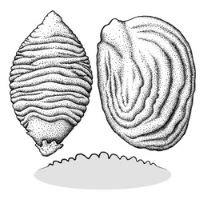 , punctatepunctate: , punctatepunctate:surface relief—dotted with pits or with translucent, sunken glands or with colored dots, similar to pitted  , reticulatereticulate: , reticulatereticulate:surface relief—netted, raised walls or concave grooves forming a net-like surface pattern with flat, concave, or convex interspaces  , alveolatealveolate: , alveolatealveolate:surface relief—reticulated, honeycombed; ridges that intersect to form polygonal cells with a regular size and shape similar to a honeycomb  , papillatepapillate: , papillatepapillate:surface relief—bearing minute, distinct, broad-based projections, tapering to a rounded apex  , ribbedribbed: , ribbedribbed:surface relief—wide, prominent, linear ridges that are generally rounded and longitudinally situated on the surface  , reticulatereticulate: , reticulatereticulate:surface relief—netted, raised walls or concave grooves forming a net-like surface pattern with flat, concave, or convex interspaces  , pittedpitted: , pittedpitted:surface relief—surface with small depressions in which the areas between the hollows do not take on the appearance of a true reticular net  , pubescentpubescent: , pubescentpubescent:surface relief—bearing hairs |
| Color(s) | black, brown, gray, green, white, orange, yellow |
| Unique features | Three-angled or lens-shapedlens-shaped: 2D shape—round and flattened with two curved (convex) surfaces achenesachene: a dry, indehiscent, one-seeded fruit, with seed attached to pericarp at a single point, derived from a single, superior, simple or compound, one-loculed ovary  or achenelike one-seeded fruits often beakedbeak: or achenelike one-seeded fruits often beakedbeak:a usually firm, terminal appendage, sometimes tapered  and with persistent stylesstyle: and with persistent stylesstyle:in a flower, the narrow and elongated part of the pistil between the stigma and the ovary; sometimes persisting in fruit 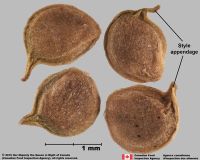 . Usually enclosed by persistent perianthperianth: . Usually enclosed by persistent perianthperianth:collective term for calyx and corolla of a flower  or membranousmembranous: or membranousmembranous:texture—extremely thin, pliable, and fairly tough sac (prophyl derived perigyniumperigynium: a sac-like structure surrounding the ovary  ). Seeds free of fruit walls. ). Seeds free of fruit walls. |
| Seed | |
| Size range | 0.3–6 mm long |
| Shape(s) | ovoidovoid: 3D shape—ovate  , fusiformfusiform: , fusiformfusiform:spindle-shaped; broadest at the middle and tapering at both ends  , ellipsoidellipsoid: , ellipsoidellipsoid:3D shape—elliptic |
| Surface relief | smooth |
| Color(s) | brown |
| Unique features | Seeds free of fruit walls, with brown, thin seed coats, usually with conspicuous raphaeraphe: a ridge or seam on the seed coat, formed by the portion of the funiculus united to the ovule wall in longitudinally curved ovules  and chalazaechalaza: and chalazaechalaza:the region at the base of the ovule where the integuments are inserted  . . |
| Other | |
| Embryo | small but well-developed, capitatecapitate: head-shaped; abruptly enlarged on one end to a relatively short, terminal portion or broad, curvedcurved: (of embryo) linear embryo is curved into an arch or horseshoe with the ends far apart  , transversetransverse: , transversetransverse:lying, situated, or placed across to seed length and basalbasal: at or pertaining to the point of attachment; (of embryo) embryo occupies one end of the seed , partially filling seed coat. Endosperm is copious and smooth, fleshy, and opaqueopaque: not transmitting light . |
| Nutritive tissue | endosperm copious, mealymealy: loose, dry, and disintegrating in finely granular pieces like meal or flour or oily, smooth, opaqueopaque: not transmitting light |
Worldwide, primarily occurring in temperate areas.
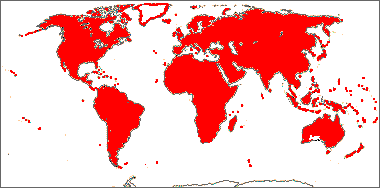
Distribution map courtesy of Angiosperm Phylogeny Website.
Baskin and Baskin 2021Baskin and Baskin 2021:
Baskin C and Baskin J. 2021. Relationship of the lateral embryo (in grasses) to other monocot embryos: A status up-grade. Seed Science Research 31 (3): 199-210. doi:10.1017/S0960258521000209; Dahlgren et al. 1985Dahlgren et al. 1985:
Dahlgren RMT, Clifford HT, and Yeo PF. 1985. The families of the monocotyledons: structure, evolution, and taxonomy. Springer-Verlag, Berlin. 520 pp.; Flora of North America Editorial Committee 1993+Flora of North America Editorial Committee 1993+:
Flora of North America Editorial Committee, eds. 1993+. Flora of North America North of Mexico [Online]. 22+ vols. Flora of North America Association, New York and Oxford. Accessed January-March 2024. URL: http://beta.floranorthamerica.org.; Kirkbride et al. 2006Kirkbride et al. 2006:
Kirkbride JH, Jr, Gunn CR, and Dallwitz MJ. 2006. Family guide for fruits and seeds, vers. 1.0. Accessed September 2020-January 2022. URL: https://nt.ars-grin.gov/seedsfruits/keys/frsdfam/index.cfm .; Kubitzki et al. 1990+Kubitzki et al. 1990+:
Kubitzki K et al., eds. 1990+. The families and genera of vascular plants. 7+ vols. Berlin etc.; Stevenson and Loconte 1995Stevenson and Loconte 1995:
Stevenson DW and Loconte H. 1995. A cladistic analysis of monocot families. In: Rudall PJ, Cribb PJ, Cutler DF, and Humphries CJ, eds. Monocotyledons: Systematics and Evolution. Royal Botanic Gardens, Kew.; Tutin et al. 1964–1980Tutin et al. 1964–1980:
Tutin TG, Burges NA, Chater AO, Edmondson JR, Heywood VH, Moore DM, Valentine DH, Walters SM, and Webb DA (eds.) 1964–1980. Flora Europaea. 5 vols. Cambridge University Press, Cambridge UK. 2,524 pp.; Zhengyi et al. 2004+Zhengyi et al. 2004+:
Zhengyi W, Raven PH, and Deyuan H. 2004+. Flora of China [online]. 25 vols. Science Press, Beijing China & Missouri Botanical Garden, St. Louis USA. Accessed January–March 2024. http://flora.huh.harvard.edu/china/
*The number of genera and species is based on Christenhusz and Byng 2016Christenhusz and Byng 2016:
Christenhusz MJM and Byng JW. 2016. The number of known plant species in the world and its annual increase. Phytotaxa 261 (3): 201-217. https://doi.org/10.11646/phytotaxa.261.3.1, which may differ from the number of genera in GRIN-Global.